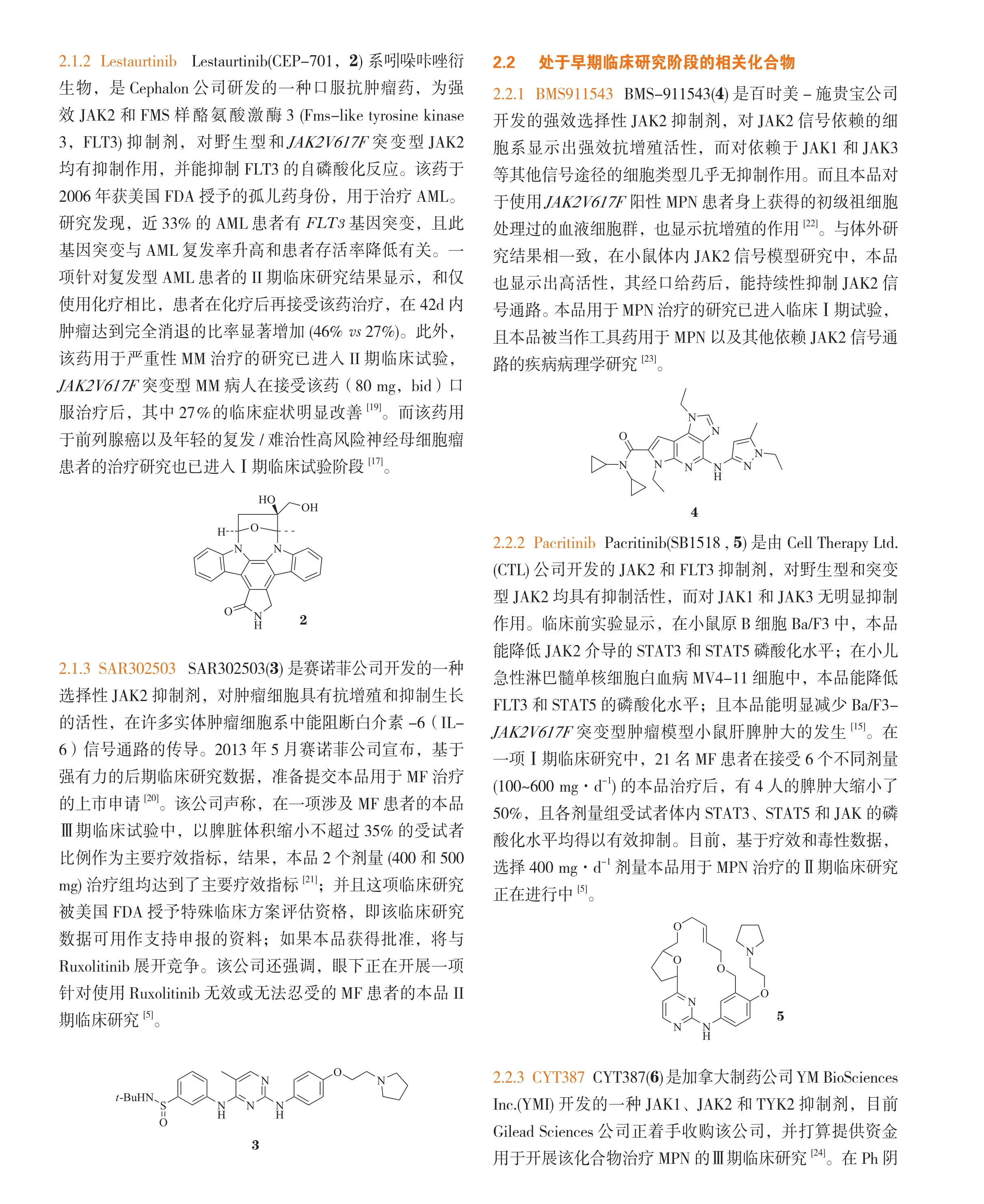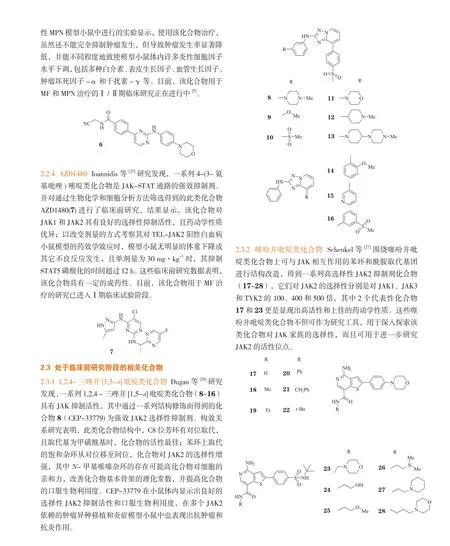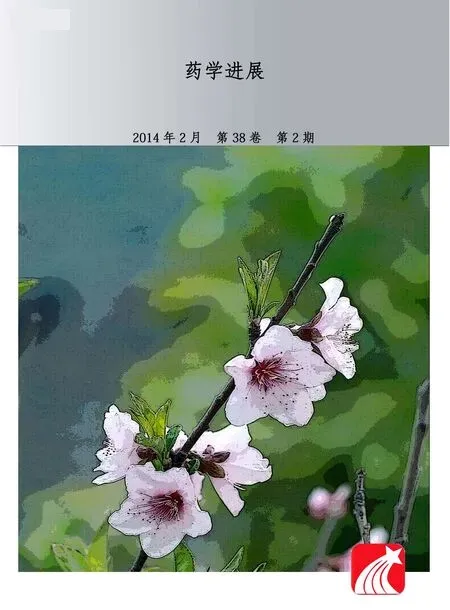小分子Janus激酶抑制剂的研究与开发
廖高鸿,曾正英,陈国良
(沈阳药科大学 基于靶点的药物设计与研究教育部重点实验室,辽宁 沈阳110016)
·综述与专论· REVIEW AND MONOGRAPH
小分子Janus激酶抑制剂的研究与开发
廖高鸿,曾正英,陈国良*
(沈阳药科大学 基于靶点的药物设计与研究教育部重点实验室,辽宁 沈阳110016)

近年来的研究发现,Janus激酶(JAK)可通过JAK-STAT信号通路对细胞增殖、分化、凋亡以及血管生成、免疫调节等起重要作用,其抑制剂可用于骨髓纤维化、恶性肿瘤以及自身免疫性疾病的防治。简介JAK-STAT通路与JAK2V617F突变,分类综述用于治疗恶性血液病和肿瘤以及自身免疫性疾病与移植排斥反应的小分子JAK抑制剂的研究与开发。
Janus激酶;JAK-STAT信号通路;Janus激酶抑制剂;肿瘤;自身免疫性疾病
2005年有4个研究小组称,在Ph阴性骨髓增生性肿瘤(Ph-negative MPN)、真性红细胞增多症(polycythemia vera, PV)、原发性血小板增多症(essential thrombocythemia, ET)以及骨髓纤维化(myelofibrosis, MF)患者体内发现了新的Janus激酶(JAK)等位基因突变即JAK2V617F突变,这种突变能诱导激活JAK[1-4]。这一发现不但为上述疾病的病理生理特征研究提供了新的切入点,而且也使JAK成为可能更有效的治疗靶点[5]。JAK是一重要的药物靶点,最初JAK抑制剂被用于治疗MF这种罕见的恶性血液疾病[6],随后进一步的研究发现JAK抑制剂在恶性肿瘤和常见的自身免疫性疾病治疗领域具有良好的应用前景,这也是目前小分子JAK抑制剂研发的两大方向。
1 JAK-STAT通路与JAK2V617F突变
1.1 JAK-STAT通路
JAK-信号传导及转录激活因子(signal transduction and activators of transcripition, STAT)通路是细胞因子信号传导的重要途径(见图1),可由多种细胞因子、生长因子以及受体激活,参与细胞增殖、分化、凋亡以及血管生成、免疫调节等过程,在肿瘤的发生、发展中起重要作用[7]。迄今,在哺乳动物体内共发现4个JAK家族成员(JAK1、JAK2、JAK3及TYK2)以及7个STAT家族成员(STAT1、STAT2、STAT3、STAT4、STAT5a、STAT5b及STAT6)。

图1 JAK-STAT通路示意图Figure 1 Diagram of JAK-STAT pathway
由图1可见,细胞因子或生长因子与细胞膜上受体结合后,这些受体首先形成同源或异源二聚体,使胞质内JAK发生聚集,紧接着邻近的JAK相互磷酸化而被激活,且促使受体上酪氨酸位点磷酸化而产生与STAT结合的区域,然后JAK接近STAT,并使STAT上一个羟基酪氨酸磷酸化,从而激活STAT,最后活化的STAT与受体分离,形成二聚体,转位至胞核,与特定的DNA片段结合,调控基因转录[8]。正常细胞中STAT的激活是快速而短暂的,而在肿瘤细胞中,STAT呈持续性激活,导致与细胞增殖、分化、凋亡、侵袭与转移以及血管生成等密切相关的基因表达异常[9-10]。因此,抑制JAK-STAT通路,即可抑制STAT的激活,进而调控肿瘤细胞中异常基因的表达,最终抑制肿瘤细胞的增殖,促进其凋亡。
1.2 JAK2V617F突变
JAK2V617F突变发生于JAK2基因的1849位,即原来的鸟嘌呤(G)被胸腺嘧啶(T)取代,导致原本617位的缬氨酸错译编码为苯丙氨酸[11]。目前的诸多研究表明,具有JAK2V617F突变的细胞中,JAK2及其信号传导通路下游的STAT5和蛋白激酶B(Akt)磷酸化水平升高;JAK2V617F突变除了可通过经典的信号传导通路激活并增强细胞因子诱导的信号级联而调节基因表达,还能通过非经典途径来调节基因转录。Dawson等[12]发现,JAK2存在于人类造血细胞的细胞核中,能直接致使组蛋白H3的41位酪氨酸(H3Y41) 磷酸化,而异染色质蛋白1A(HP1A)可借助染色体阴影域特异性地结合于细胞核内组蛋白H3的这一区域,然后通过表观遗传学机制介导基因沉默,由JAK2诱导的H3Y41磷酸化则能阻止这种结合。另有研究显示,抑制白血病细胞中JAK2的活性,能降低H3Y41磷酸化水平,间接促进HP1A与组蛋白H3的特异性结合,最终促使致癌基因沉默[13-15]。
2 用于治疗恶性血液病和肿瘤的小分子JAK抑制剂
2.1 已上市或准备申请上市的相关药物
2.1.1 Ruxolitinib Ruxolitinib(1)是美国Incyte公司开发的一种选择性JAK1和JAK2抑制剂,2011年获美国FDA批准,成为首个专门治疗MF的药物[5]。研究表明,该药具良好安全性,对非靶器官无毒性;且除了对MF具有显著疗效外,其对多种血液疾病也有良好的治疗作用。临床研究显示,MF患者使用该药治疗32个月后,总生存率达69%,且经该药长期治疗后,脾肿大症状明显改善[16]。目前,该药用于原发性和继发性红细胞增多症及ET治疗的Ⅲ期临床研究正在进行中,用于继发性MPN、急性骨髓性白血病(AML)及银屑病的治疗研究均已进入II期临床试验阶段,且用于其他白血病、前列腺癌和多发性骨髓瘤(MM)的治疗也在研究中[17]。临床研究显示,18例AML患者接受该药治疗后,3例有明显的疗效反应,均达到完全缓解,且血球计数显著改善[18]。





疾病时,均能产生良好疗效,且并不一定会造成较大副作用,如多激酶抑制剂对肿瘤的治疗非常有效;而另一方面,虽然目前对于选择性JAK抑制剂的作用机制及疗效不甚明确,但高选择性的JAK1、JAK2、JAK3和TYK2抑制剂可能会有效减少因作用于其他JAK家族成员而引发的不良反应。因此,选择性JAK抑制剂已成为目前的研究热点,且有理由相信,随着多激酶抑制剂和高选择性JAK抑制剂研究的不断深入,其在各类疾病治疗领域的应用必将更加广泛。
[1]Baxter E J, Scott L M, Campbell P J, et al. Acquired mutation of the tyrosine kinase JAK2 in human myeloproliferative disorders [J]. Lancet, 2005, 365(9464): 1054-1061.
[2]James C, Ugo V, Couedic J P, et al. A unique clonal JAK2 mutation leading to constitutive signalling causes polycythaemia vera [J]. Nature, 2005, 434(7037): 1144-1148.
[3]Kralovics R, Passamonti F, Buser A S, et al. A gain-of-function mutation of JAK2 in myeloproliferative disorders [J]. N Engl J Med, 2005, 352(17): 1779-1790.
[4]Levine R L, Wadleigh M, Cools J, et al. Activating mutation in the tyrosine kinase JAK2 in polycythemia vera, essential thrombocythemia, and myeloid metaplasia with myelofibrosis [J]. Cancer Cell, 2005, 7(4): 387-397.
[5]Santos F P S, Verstovsek S. JAK2 Inhibitors: are they the solution? [J]. Clin Lymphoma Myeloma Leuk, 2011, 11(Suppl 1): 28-36.
[6]虞忠, 肖坤全. JAK抑制剂临床研究进展 [J]. 海峡药学, 2012, 24(1): 18-20.
[7]Smimova O V, Ostroukhova T Y, Bogorad R L. JAK-STAT pathway in carcinogenesis: is it relevant to cholangiocarcinoma progression? [J]. World J Gastroenterol, 2007, 13(28): 6478-6491.
[8]Behrmann I, Smyczek T, Heinrich P C, et al. Janus kinase (Jak) subcellular localization revisited: the exclusive membrane localization of endogenous Janus kinase 1 by cytokine receptor interaction uncovers the Jak receptor complex to be equivalent to a receptor tyrosine kinase [J]. J Biol Chem, 2004, 279(34): 35486-35493.
[9]Yu H, Pardoll D, Jove R. STATs in cancer inflammation and immunity: a leading role for STAT3 [J]. Nat Rev Cancer, 2009, 9(11): 798-809.
[10]Vainchenker W, Constantinescu S N. JAK/STAT signaling in hematological malignancies [J]. Oncogene, 2013, 32(21): 2601-2613.
[11]陈怡欣, 李英, 张凌岩,等. JAK2V617F 突变在骨髓增殖性肿瘤中的研究进展[J]. 中国实验血液学杂志, 2011, 19( 5): 1329-1333.
[12]Dawson M A, Bannister A J, Gottgens B, et al. JAK2 phosphorylates histone H3Y41 and excludes HP1alpha from chromatin [J]. Nature, 2009, 461(7265): 819-822.
[13]Bannister A J, Zegerman P, Partridge J F, et al. Selective recognition of methylated lysine 9 on histone H3 by the HP1 chromo domain [J]. Nature, 2001, 410(6824): 120-124.
[14]Lachner M, O’Carroll D, Rea S, et al. Methylation of histone H3 lysine 9 creates a binding site for HP1 protein [J]. Nature, 2001, 410(6824): 116-120.
[15]Tefferi A, Pardanani A. JAK inhibitors in myeloproliferative neoplasms: Rationale, current data and perspective [J]. Blood Rev, 2011, 25(5): 229-237.
[16]Verstovsek S, Kantarjian H M, Estrov Z, et al. Long-term outcomes of 107 patients with myelofibrosis receiving JAK1/JAK2 inhibitor ruxolitinib: survival advantage in comparison to matched historical controls [J]. Blood, 2012, 120(6):1202-1209.
[17]Kontzias A, Kotlyar A, Laurence A, et al. Jakinibs: a new class of kinase inhibitors in cancer and autoimmune disease [J]. Curr Opin Pharmacol, 2012, 12(4): 464-470.
[18]Eghtedar A, Verstovsek S, Estrov Z, et al. Phase 2 study of the JAK kinase inhibitor ruxolitinib in patients with refractory leukemias, including postmyeloproliferative neoplasm acute myeloid leukemia [J]. Blood, 2012, 119 (20): 4614-4618.
[19]Santos F P, Kantarjian H M, Jain N, et al. Phase 2 study of CEP-701, an orally available JAK2 inhibitor, in patients with primary or postpolycythemia vera/essential thrombocythemia myelofibrosis [J]. Blood, 2010, 115(6):1131-1136.
[20]Nguyen K. Market watch: upcoming market catalysts in Q2 2013 [J]. Nat Rev Drug Discov, 2013, 12(4): 254.
[21]Grogan K. Sanofi to submit JAK inhibitor for MF [EB/OL].[2013-5-17]. http://www.pharmatimes.com/Article/ 13-05-17/Sanofi_to_ submit_JAK_inhibitor_for_MF.aspx.
[22]Pardanani A, Hood J, Lasho T, et al. TG101209, a small molecule JAK2-selective kinase inhibitor potently inhibits myeloproliferative disorder-associated JAK2V617F and MPLW515L/K mutations[J].Leukemia, 2007, 21(8): 1658–1668.
[23]Purandare A V, McDevitt T M, Wan H, et al. Characterization of BMS-911543, a functionally selective small molecule inhibitor of JAK2 [J]. Leukemia, 2012, 26(2): 280-288.
[24]Palmer E. Gilead caps 2012 roll by bagging cancer drugmaker- Gilead will pay $510 million for YM BioSciences [EB/OL]. [2012-12-12]. http://www.fiercepharma.com/story/ gilead –caps-2012-rollbagging- cancer- drugmaker /2012-12-12.
[25]Ioannidis S, Michelle L L, Wang T, et al. Discovery of 5-chloro-N2-[(1S)-1-(5- fluoropyrimidin-2-yl)-ethyl]-N4- (5-meth-yl-1H-pyrazol-3-yl)-pyrimidine-2,4-diamine (AZD1480) as a novel inhibitor of the Jak/Stat pathway [J]. J Med Chem, 2011, 54(1): 262-276.
[26]Dugan B J, Gingrich D E, Mesaros E F, et al. A selective, orally bioavailable 1, 2, 4-triazolo [1, 5-a] pyridine-based inhibitor of Janus kinase 2 for use in anticancer therapy: discovery of CEP-33779 [J]. J Med Chem, 2012, 55(11): 5243-5254.
[27]Schenkel L B, Huang X, Cheng A, et al. Discovery of potent and highly selective thienopyridine janus kinase 2 inhibitors [J]. J Med Chem, 2011, 54(24): 8440-8450.
[28]Hanan E J, Abbema A, Barrett K, et al. Discovery of potent and selective pyrazolopyrimidine janus kinase 2 inhibitors [J]. J Med Chem, 2012, 55(22): 10090-10107.
[29]Lim J, Taoka B, Otte R D, et al. Discovery of 1-amino-5H-pyrido-[4,3-b]indol- 4- carboxamide inhibitors of Janus kinase 2 (JAK2) for the treatment of myeloproliferative disorders [J]. J Med Chem, 2011, 54(20): 7334-7349.
[30]Eustice C. Xeljanz (tofacitinib)-what you need to know first JAK inhibitor for rheumatoid arthritis approved by FDA [EB/OL]. [2012-09-19]. http://arthritis.about.com/od/dmards/a/ Xeljanz- Tofacitinib-What-You-Need-To-Know.htm.
[31]Flanagan M E, Blumenkopf T A, Brissette W H, et al. Discovery of CP-690,550: a potent and selective Janus kinase (JAK) inhibitor for the treatment of autoimmune diseases and organ transplant rejection [J]. J Med Chem, 2010, 53(24): 8468-8484.
[32]Kulagowski J J, Blair W, Bull R J, et al. Identification of imidazopyrrolopyridines as novel and potent JAK1 inhibitors [J]. J Med Chem, 2012, 55(12): 5901-5921.
[33]Vincenti F, Tedesco S H, Busque S, et al. Randomized phase 2b trial of tofacitinib (CP-690,550) in de novo kidney transplant patients: efficacy, renal function and safety at 1 year [J]. Am J Transplant, 2012, 12(9): 2446-2456.
[34]Boy M G, Wang C S, Wikinson B E, et al. Double-blind, placebocontrolled, dose-escalation study to evaluate the pharmacologic effect of CP-690,550 in patients with psoriasis [J]. J Invest Dermatol, 2009, 129(25): 2299–2302.
[35]Sandborn W J, Ghosh S, Panes J, et al. Tofacitinib, an oral Janus kinase inhibitor, in active ulcerative colitis [J]. N Engl J Med, 2012, 367(7):616-624.
[36]Fridman J S, Scherle P A, Collins R, et al. Selective inhibition of JAK1 and JAK2 is efficacious in rodent models of arthritis: preclinical characterization of INCB028050 [J]. J Immunol, 2010, 184(9): 5298-5307.
[37]Greenwald L G, Greenwald M W. JAK: no longer ‘just another kinase’ [J]. Int J Clin Rheumatol, 2011, 6(4): 401-410.
[38]Fleischmann R, Spencer-Green G T, Fan F, et al. 2011 ACR/ARHP annual scientific meeting late-breaking abstracts [J]. Arthritis Rheum, 2011, 63(12): 4041-4047.
[39]Abbott. Abbott and Galapagos announce global collaboration for novel oral therapy, GLPG0634, in phase II to treat autoimmune diseases [EB/ OL]. [2012-02-29]. http: // www.abbott.com/ news- media/pressreleases/ abbott-and –galapagos –announce -global-collaborationfor-novel-oral-therapy-glpg0634-in-phase-ii-to.htm.
[40]Randhawa J, Ostojic A, Vrhovac R, et al. Splenomegaly in myelofibrosis-- new options for therapy and the therapeutic potential of Janus kinase 2 inhibitors [J]. J Hematol Oncol, 2012, 5(43): 1-7.
[41]Velotta J B, Deuse T, Haddad M, et al. A novel JAK3 inhibitor, R348, attenuates chronic airway allograft rejection [J]. Transplantation, 2009, 87(5): 653-659.
[42]Deuse T,Velotta B, Govaert J A, et al. Novel immunosuppression: R348, a JAK3 and Syk-inhibitor attenuates acute cardiac allograft rejection [J]. Transplantion, 2008, 85(6): 885-892.
Research and Development of Small Molecule Janus Kinase Inhibitors
LIAO Gaohong, ZENG Zhengying, CHEN Guoliang
(Key Laboratory of Structure-Based Drug Design & Discovery, Ministry of Education, Shenyang Pharmaceutical University, Shenyang 110016, China)
It has been found in recent years that Janus kinase (JAK) could play a key role on the cellular proliferation, differentiation, and apoptosis as well as angiogenesis and immunoregulation through JAK-STAT signaling pathway, and its inhibitors could be used in the prevention and treatment of myelofibrosis, malignant tumors and autoimmune diseases. JAK-STAT pathway and JAK2V617F mutation were briefly introduced. The research and development of small molecule JAK inhibitors used for the treatment of malignant hempathy, tumors, autoimmune diseases and graft rejection were classifiedly reviewed.
Janus kinase; JAK-STAT signaling pathway; JAK inhibitor; tumor; autoimmune disease
R979.1;R979.5
A
1001-5094(2014)02-0112-08
接受日期:2013-11-20
*通讯作者:陈国良,教授;
研究方向:抗癌药物研究;
Tel:024-23986412;E-mail:guoliang222@gmail.com

